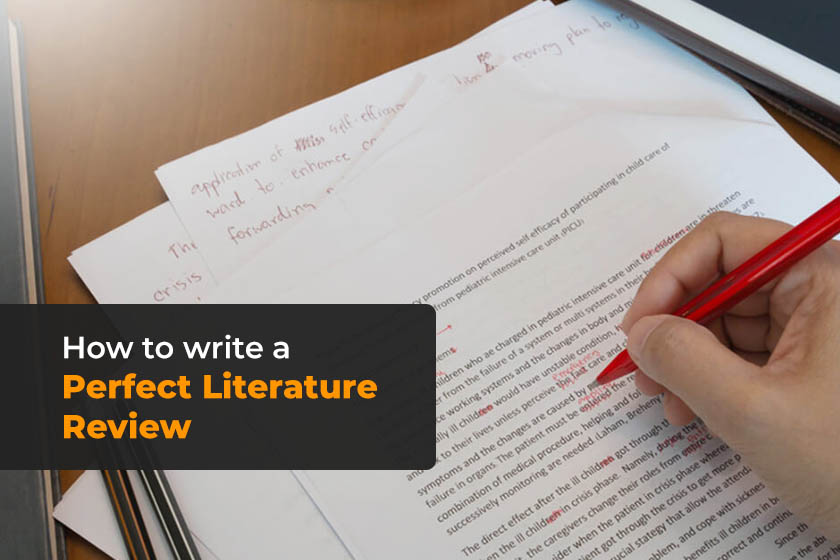
The literature review is a study of academic sources like journal articles, books, and any dissertation. This part of a research paper gives a synopsis of the main discoveries, notions, and progress following the research question or an issue. A perfect literature review do not just explain findings but it also examines, evaluates and critically analyze the findings, use discoveries to point out the theme, structure and a void between the past findings that could be covered in the current one and also presents the scenario of an array of knowledge that concerns the current research problem, question or hypothesis,
Table of Contents
Why do we write a Literature Review?
The reason for writing a literature review in any research paper, thesis or dissertation is that this part delivers an overview of all the past findings concerning the topic of the paper and an opportunity for the researcher to make a mark in h/her academic field. The literature review offers the reader a full overview of multiple sources in one place about a particular topic. Through this, the reader understands what the writer aims to research and why the researcher is interested in this topic.
Types of Literature Review:
There are two main kinds of data conducted before writing a literature review, first is the primary data where surveys are conducted and published and second is the secondary data where the data is already there then the writer analyzes the data and updates the previous research. The literature review has many types that can include either kind of data and the type of the literature review is under the study conducted by the researcher. The types of the literature review are given below:
- Argumentative Review:
This type of literature review is written when the topic is supporting an issue, argument or any conflict. The sole purpose of this literature review that it creates a contradicting point of view.
- Integrative Review:
This type of literature review criticizes or critiques previous literature of a particular topic in such a way that new agendas and viewpoints are produced.
- Methodological Review:
This type of literature review examines the different types of research methods and offers a framework to understand the topic or the theory of the research paper
- Theoretical Review:
This literature review studies a theory or a concept as a whole, this type of literature review also tries to point out the gaps in the previous theories and often discovers that the recent theories are inappropriate in defining advance research issues.
Perfecting the Literature Review:
There are few steps in which a student can perfect a literature review in their paper, dissertation or thesis.
Step 1: Gather, Analyze and Choose Literature:
Before the writer starts to search for the findings, h/she needs a specific topic for h/her thesis or dissertation. In the case of a dissertation or a research paper, you will find literature related to the research issue or question. This is considered to be the first step to understand what is your topic about before starting your research on your own. If the task of any paper is an individual task then the student only needs to concentrate and create a question that revolves around the topic so that it is easy to find literature on any particular topic. A dissertation research question is different from the above because the student has to answer the question on the bases of the prior research and publications.
- Use keywords or citation to search for literature:
Many search engines will help you to find a literature review on your specific topic and will make it easy for you to find:
- University’s Digital Library
- Google Scholar
- JSTOR
- Econ Lit (economics)
- Sci-Hub
- Inspec (physics, engineering, and computer science)
When you come across an important article that you feel will be relevant in your literature review, check the paper’s reference list to discover more useful articles. You might find multiple articles in the citations or reference list of a particular paper, search for them using any search engines to clearly understand about the paper. Google Scholar also tells the researcher how many times a paper has been cited – more citation means that the specific paper has made a reputable achievement in the field of study.
- Analyze and choose sources:
For starters, you are a human being and you won’t be able to read every single part of every paper so first read abstracts of every paper to conclude whether the specific paper or dissertation to add in your literature review is useful or not. The student has to analyze which of the journal articles, books or thesis are relevant to the research questions. There are many questions that the student should ask themselves while reading a paper:
- What is the main research question that the author is focusing upon?
- What are the main concepts or theories in the paper?
- What are the findings, conclusions, and recommendations of the paper?
- Does the paper relate to other literature in your field?
- How can this paper contribute to your literature or your paper?
There are many other questions, but these are the most common ones. Do make sure you read the relevant and useful theories in the field that you are researching upon, don’t just stick to the papers also search relevant concepts that can change the course of your research.
- Write notes and citations:
Whenever you are researching for your literature, always keep a note pad with you and you may never know there must be important keynotes that you want to include in your literature review about your topic. Always cite your sources because without citations there can be a high percentage of plagiarism.
Step 2: Connections and Themes:
This step entails shaping the literature review in correct form so that the reader isn’t easily confused, the writer must look for any connection among the articles the h/she has read. The students can identify:
- Movements and Outlines: this concerns theories, different frameworks or results, are there any strategies that have become more or less famous over some time?
- Themes: what kind of notions or questions persist in the research?
- Key Publications: What are the main theories or concepts that can change the course of the field.
- Void: What do the prior researches lack? what is missing in the previous literature that needs to be covered in your paper?
This stage will be useful in constructing the literature review and it might put a mark of your contribution in the field.
Step 3: Structuring the literature review:
There are multiple ways in which you can construct your literature review. Before you start writing the body of the literature review you should have a coarse idea of what approach you will apply. You can also combine two themes to make it look promising.
- Chronological:
This type of strategy is the easiest one that entails observing the growth of the topic over time. Nevertheless, selecting this approach doesn’t just give an overview of the sources rather evaluate the different frameworks, critically analyze the sources and identify main concepts that are responsible for changing the course of the field.
- Thematic:
If the student came across different themes or theories h/she can divide the literature review into different headings or subheadings.
- Methodological:
This type of strategy includes structuring your literature review on the bases of different research methods, you can also compare and contrast the different findings of the literature.
- Theoretical:
This type of strategy sometimes is addressed as the bases for a literature review. This method describes different concepts, notions, models and main theories. The student can argue in the literature review about a particular theory or approach or can make his pattern or framework.
Step 4: Writing the literature review:
The literature review consists of an introduction, body, and conclusion. The inclusion of the data solely depends upon the research objectives and problems of the topic.
- Introduction: This part should create the emphasis and purpose of the literature review.
- Body: the body can be divided into multiple subheadings or headings based on the length of the literature review. The subheading can be of any theme like any historical moment or period or any strategy. The student can follow the main pointer given below:
- Summarize the content: give a brief and concise explanation from each source and amalgamate them into one big paragraph.
- Evaluate and infer: literature review doesn’t just include paraphrasing of the different papers but the writer needs to critically evaluate the publications and theories and infer the results of these articles.
- Paragraphs: the student must write the body of the review in well-organized paragraphs and also make use of topic sentences in these paragraphs to distinguish between them.
- Conclusion: in this part of the literature review the writer summarizes the main concepts and the results. The writer also focuses on the importance of the literature. This also includes how the research is in accordance to the topic.
2.1. Overview of knowledge concept
The concept of knowledge has become more exciting since rapidly industrializing economies have resulted in a transition from natural resources to intellectual resources. Knowledge is characterized as information in the light of comprehension that knowledge should be applied (Brooking, 1999). Nanaka and Takeuchi (1995) represented knowledge as “Justified true conviction- the notion that knowledge can be vindicated by facts.” Two different types of knowledge exist such as tacit and explicit. Tacit knowledge is specific and personal, making it hard to formalize, interact and express with others (Nonaka & Takeuchi, 1995). Tacit knowledge comprises a technical aspect which is often related to as know-how and a cognitive aspect that contains strategies, mental configurations, and belief systems. Explicit knowledge in information systems can be developed and accessed. Western thought has focused on explicit knowledge. This practice derives from cartesian dualism, which certainly distinguishes between mind and matter and therefore between mind and body. In the culture of Japanese reasoning, knowledge is generally seen principally as something that is not clearly visible and easily interpretable, i.e. tacit by nature (Nonaka & Takeuchi, 1995).
Building on a rapidly growing concern in how organizations could strategically handle knowledge more than two decades ago, scholars such as Grant (1996), Spender (1994) and Nonaka and Takeuchi (1995) specialized companies’ knowledge-based views. This work stated that individuals and organizations are using knowledge as the main driver of consistent competitive advantage. The highly influential book of Nonaka and Takeucki, “The Knowledge Creating Company” (1995) is published. Their spiral process theory of the creation of knowledge is centered on a spiral motion between both types of knowledge i.e. explicit and tacit. Nonaka and Takeucki argued that the formation of knowledge is the result of a gradual cycle of four embedded mechanisms such as externalization, internalization, combination, and socialization.
Knowledge is by far the most useful intangible asset that competitors can not readily imitate. It will cause the company’s birth to innovation. Knowledge will modify the ancient ways of doing business in order to make a business more successful (Tundung, Ludfi & Hanif, 2017).
In present organizations, knowledge plays an extremely significant role. Business processes are complicated and complex, knowledge work needs to replace manual labor, which requires a high level of competence and skills. Knowledge and expertise of worth to the organization appear to be encapsulated in people who are hard to replace. Creative thinking and knowledge become valuable factors of production in new economies of the world, in addition to capital, labor, land and nature resources. The value of knowledge for development is likely to increase, and knowledge could affect the distinction between growth and deprivation (Sedziuviene & Vveinhardt, 2010).
2.2. The concept of knowledge management
Knowledge management is defined as an evolving concept of management and described as a procedure applied by different companies to come up with different ideas from relevant sources or from academic sources. It includes a variety of techniques and methods used in a company to develop and reflect additional insight and perspectives. The concept was introduced in the middle of the 1980s when two scholars, Davenport and Prusak wrote about knowledge management that became famous and was called Working Knowledge (Akram, Siddiqui, Nawaz, Ghauri & Cheema, 2011). The two notions Market and Knowledge management intersect in multiple important ways however, according to many scholars there isn’t much of the intersection when applying these two in the practical field. Nonaka (2007) likes to call knowledge management as knowledge-based management and share information with people in order to develop a competitive advantage.
Knowledge management is known as a renowned and emerging educational and business field and it develop in the nineties. Knowledge management based organizations begin implementing knowledge management programs globally to enhance business process reliability, improve the productivity and performance of their services, and seek out new alternatives and products for their users (Nam Nguyen & Mohamed, 2011). Furthermore, Du Plessis (2007) described that innovation is generally an ultimate result of knowledge management effectiveness in technological contexts and one of the main objectives for knowledge-building organizations is the search for comparative advantages in the field (Nonaka & Takeuchi, 1995).
2.3. The concept of innovation
Shaw and Williams (2009) stated that innovation is further than the idea of knowledge sharing which is known to be the key element of innovation. Moreover, knowledge is a resource of strategic value for innovation practices (Xie, Fang, Zeng & Huo, 2016), which makes appropriate knowledge management an important method for improving a company’s innovation capacity (Hamdoun, Jabbour & Othman, 2018).
The process of innovation depends largely on knowledge, particularly on tacit knowledge. By integrating basic form of knowledge into special type of knowledge, as a result, new and valuable knowledge is formed and transformed into products, services and processes. Nonaka’s work on knowledge creation considers knowledge as a key requirement for innovation and competitiveness (Lopez-Nicolas & Merono-Cerdan, 2011)
The most important factor for knowledge management’s part in innovation in the current organization atmosphere to formulate, build and preserve competitive advantage by utilizing knowledge and teamwork procedures (Du Plessis, 2007). However, preserving and constructing an innovative process has become really difficult and confusing because of the changes in customer’s desires, an increase in competition and technological advancements (Cavusgil, Calantone & Zhao, 2003). The knowledge management can be implemented to the procedure of innovation through the incorporation of internal and external knowledge to the business hence presenting it more reachable. Knowledge can be distributed, evaluated, polished and made accessible when it is needed the most. Knowledge is integrated through knowledge management base, techniques and procedures should, therefore, enable likeness to permit individual and structural education and innovation. The integration of knowledge entails the ability to link, adjust and represent active organization knowledge and data. With an efficient data and knowledge management that contribute to knowledge integration which in order can improve innovation, companies could be efficiently using knowledge as an innovation source (Badii & Sharif, 2003).
2.4. The concept of marketing innovation
Researches directed for the field of marketing should be the key provider for knowledge management offering ideas on clientele, about their behavior and demographics which can be helpful in consumer communications, relationship approaches and strategies (Bosilj & Jurinjak, 2009). Knowledge management overlaps by the concept of marketing by providing knowledge for marketing communications, knowledge for targeting the consumers and selecting various means of communication (Bosilj & Jurinjak, 2009).
Knowledge is one of the significant resources in creating marketing innovation by adding sustainable competitive advantage. Rodrigues, Millan, Salguerlo & Gutlerrez (2013) conducted their research on cultural restriction effect on the connection between knowledge strategies and innovation involving healthcare companies in their research. They concluded that knowledge management approaches lead the knowledge base and they also investigated that cultural restrictions restrain the knowledge management and innovation connection. They also said that their paper discovers the significance of attaining and exercising knowledge in a culture that motivates the sharing of knowledge. Eventually from their research, it is prominent that there will be creativity and innovation through knowledge management when cultural restrictions are reduced. Furthermore, knowledge management and innovation in this new era are two significant approaches used by companies to increase their productivity. The companies’ desire for innovation stems from an increase in the competition among other companies, demands of the consumers and new market locations (Vafaie, Rahimi, Rostami & Shad, 2016).
2.5. Knowledge management and marketing innovation
A model was proposed by Carneiro (2005) that draws a bridge between knowledge management, innovation, and competitiveness, in which he reported that the model links the three and points the tactical nature of the growth of knowledge. He concluded that knowledge management has a positive impact on innovation and competitiveness. The knowledge management structure enlarges the creativity span that is to enhance the innovation method through faster admittance and measure of original different knowledge. Knowledge transfer is one way of bringing innovation in the organizational framework. Efficient knowledge management is a crucial success element when a new commodity or good is introduced. So, one of the main elements impacting the innovation process is knowledge management in many companies (Lopez-Nicolas & Merono-Cerdan, 2011). A strategy was introduced that reused the previous knowledge for the innovation through understanding the procedure for reusing the knowledge when innovation is highly predictable, the approach was introduced by Majchrazk, Cooper, and Neece (2004). They also highlighted the difficulties and strategies involved to reuse others’ ideas by evaluating them and by filling up the performance void by making use of others’ knowledge.
Du Plessis (2007) reports that knowledge management helps in constructing different techniques, different bases and procedure for the formation of tacit knowledge as well as distribution and influence in the companies that plays a significant part in the innovation procedure. He also reports that knowledge management guides in detecting void in the knowledge platform and offers the procedure to seal the voids to support the innovation process. Knowledge management also offers a culture that is determined by knowledge in which the innovation process can be nurtured (Uden & Naaranoja, 2011). The products or services that are on the bases of knowledge aren’t produced in a large number but are produced according to the needs of the consumers. As these products and services are innovatively produced, they do not have a long-life span rather they are customized and are according to the changes in the environment (Entezari & Mahjoub, 2013 as cited in Pourabbasi & Alhosseini, 2017). In another paper, Goh (2005) introduced a cohesive management outline to bind knowledge management and innovation. The author defined why the innovation process is not that different from knowledge management as well as the part of knowledge formation and the worth of knowledge capital to sustain the knowledge to fetch innovation. He also claimed that to encourage innovations the companies should assist guidelines that are made in accordance with knowledge management.
Explore the depths of the Gloria Jeans Coffee business report with Assignmentstudio. Our detailed analysis illuminates key insights, offering invaluable perspectives for stakeholders interested in understanding the intricacies of this renowned brand.
Unlock the secrets of effective Literature Reviews with Assignmentstudio. Our comprehensive insights into How to write a Literature Review provide invaluable techniques and strategies for crafting compelling academic narratives.
Navigate the complexities of falls in old age and its implications for identity with Assignmentstudio. Our insightful literature review, ‘Falls in Old Age – A Threat to Identity: A Qualitative Study,’ provides a nuanced understanding for researchers and practitioners.







